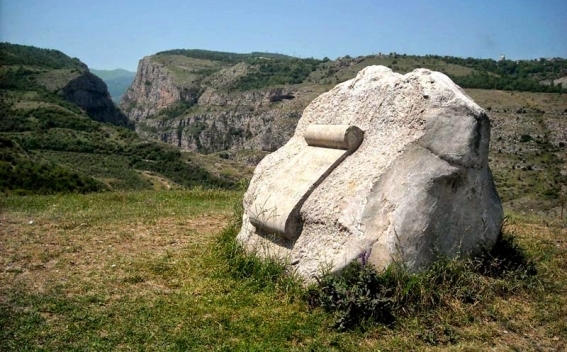Pele Pughi Monument - Symbol of Humor and Joy of Artsakh People

For the people of Artsakh humor has become an integral part of their character, regardless of everything. And the monument to a jester of Melik Shahnazar the Second (the ruler of Varanda) - Pele Pughi - became a symbol of their love towards humor and joy.
The monument to Pughi is located in a cave between the villages of Shosh and Mkhitarashen. It was built in 1976.
A question arises; who was the famous Artsakh citizen who became a symbol of joy?
Pele Pughi is a real person. He was born in 1731 in Shosh village of Varanda. His real name was Paul (Պողոս - in Armenian), but he is better known in Artsakh as Pele Pughi (Պըլը Պուղի - in Armenian). The word ''Pele'' in Armenian means ''mad'','' crazy'', which proves the comical nature of his folk character.
Pughi had a great reputation in Artsakh. His fame also spread orally by a word of mouth beyond the borders of his native land. Melik Shahnazar the Second, the ruler of Varanda, hearing about his ingenuity, invited him to live in his court.
In court Pele Pughi was more than a jester. He occupied a position of jester-advisor. But it should be mentioned, that he didn’t flatter Melik Shahnazar, moreover, with his witty remarks he tried to direct him, showing the truth and the right path.
Pughi invented funny stories and fables, which due to the people of Artsakh, reached our days. Makar vardapet Barkhudaryants was the first who wrote down 189 funny stories and fables by Pughi, after which in 1883 he published them in Tbilisi (Georgia) under the title '' Pele Pughi ''.
Later other folklore collectors - S. Israelyan, M. Grigoryan-Spandaryan, Hrachya Beglaryan- also collected and published Pughi’s works.
His funny stories and fables are not only humorous, they contain also sententious tendency and show the vicious aspects of life and social relations of that time.
Many materials of Pughi are preserved in the Institute of Archaeology and Ethnography of National Academy of Sciences of Armenia, in the Museum of Literature and Art after Yeghishe Charents in Yerevan and elsewhere.
Although Pele Pughi died in 1810, he still lives in the memory of Artsakh people. Nowadays you can’t find a person in Artsakh, who isn’t aware about him. And his monument, which is situated in Hunot canyon, makes brighter and passes on his memory and fame from generation to generation.
Other materials on this subject
- Artsakh's Guardian Angel - St. Savior Ghazanchetsots Cathedral (Virtual Tour) Chazanchetsots Cathedral is one of the most prominent Armenian churches.
- Askeran Fortress Has a Great Scientific, Study and Historical Significance for Artsakh The fortress has served as a secure military base from the begging of its construction.
-
 17:08
17:08The regular session of the Anti-corruption Policy Council takes place in Jermuk
-
 15:05
15:05The Prime Minister sends congratulatory messages to the supreme leader of Iran and the President of Iran
-
 11:11
11:11Armenia sends earthquake aid to Turkey
-
 10:43
10:43Commemoration of the Pontiff St. Sahak Partev
-
 09:16
09:16Some roads are closed and difficult to pass in Armenia
-
 19:55
19:55Phone conversation of the Foreign Minister of Armenia with the U.S. Assistant Secretary of State for European and Eurasian Affairs
-
 18:30
18:30Prime Minister Pashinyan and President Khachaturyan meet
-
 18:20
18:20Ararat Mirzoyan with Co-Chairman of the OSCE Minsk Group of France Brice Roquefeuil
-
 17:01
17:01Humans could land on Mars within 10 years, Musk predicts
-
 16:45
16:45France, US urge 'immediate' end to Nagorno Karabakh blockade
-
 16:01
16:01Blockaded Nagorno Karabakh launches fundraiser to support quake-hit Syria
-
 15:59
15:59Earthquake death toll in Turkey rises to 18,342
-
 15:43
15:43Ararat Mirzoyan Held a Telephone Conversation with Sergey Lavrov
-
 15:06
15:06French president rules out fighter jet supplies to Ukraine in near future
-
 14:47
14:475 Day Weather Forecast in Armenia
-
 14:44
14:44President Vahagn Khachaturyan wrote a note in the book of condolences opened in the Embassy of Syria in Armenia
-
 14:20
14:20Azerbaijan’s provocations impede establishment of peace and stability – Armenian FM tells Russian Co-Chair of OSCE MG
-
 12:57
12:57France representation to OSCE: Paris calls on Azerbaijan to restore freedom of movement through Lachin corridor
-
 11:40
11:40Command of Kosovo forces highly appreciated preparation of Armenian peacekeepers
-
 10:16
10:16The United States withdrew from sanctions against Syria for six months the provision of assistance after the earthquake
day
week
month
Humidity: 21%
Wind: 1.54 km/h









